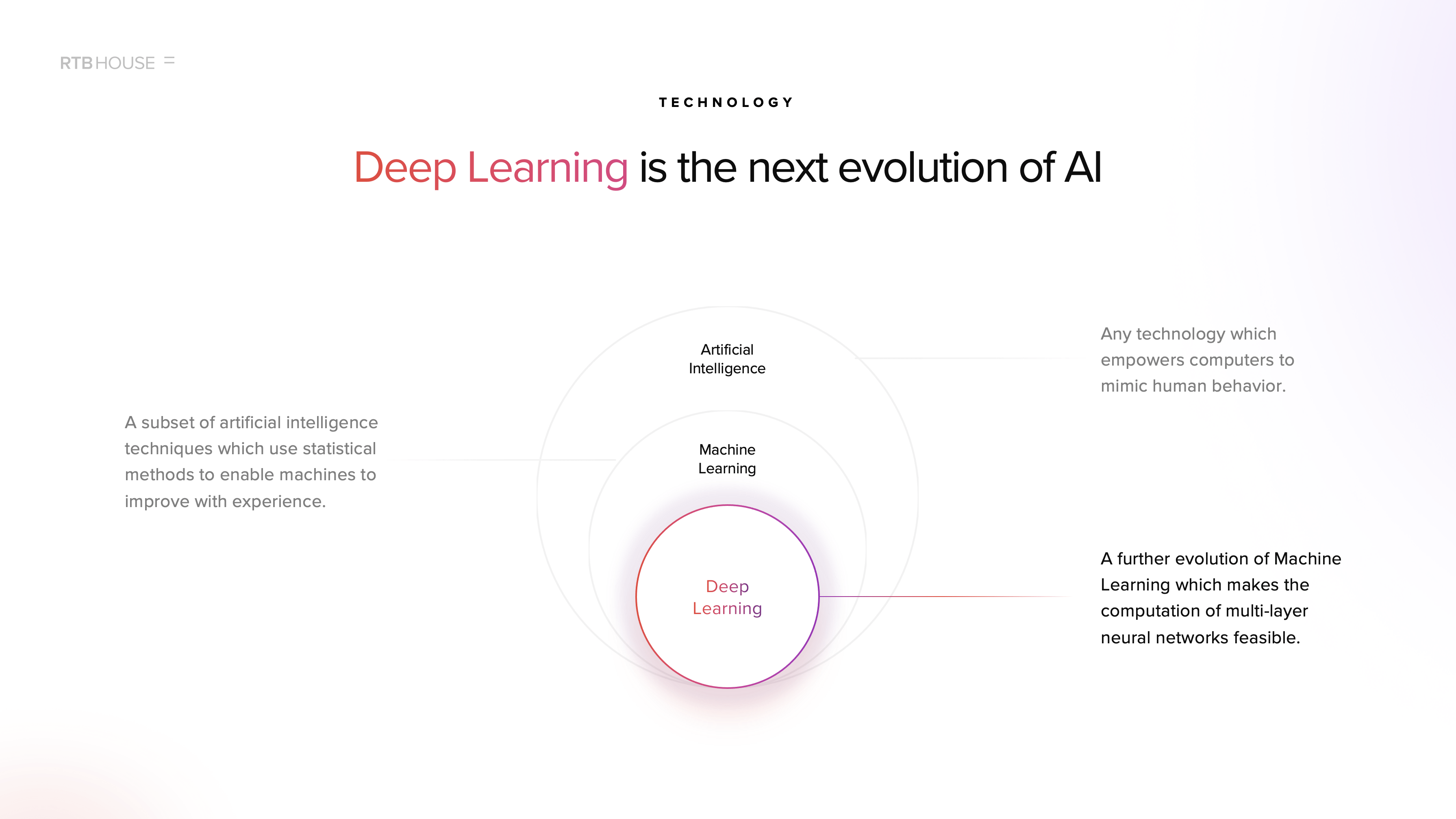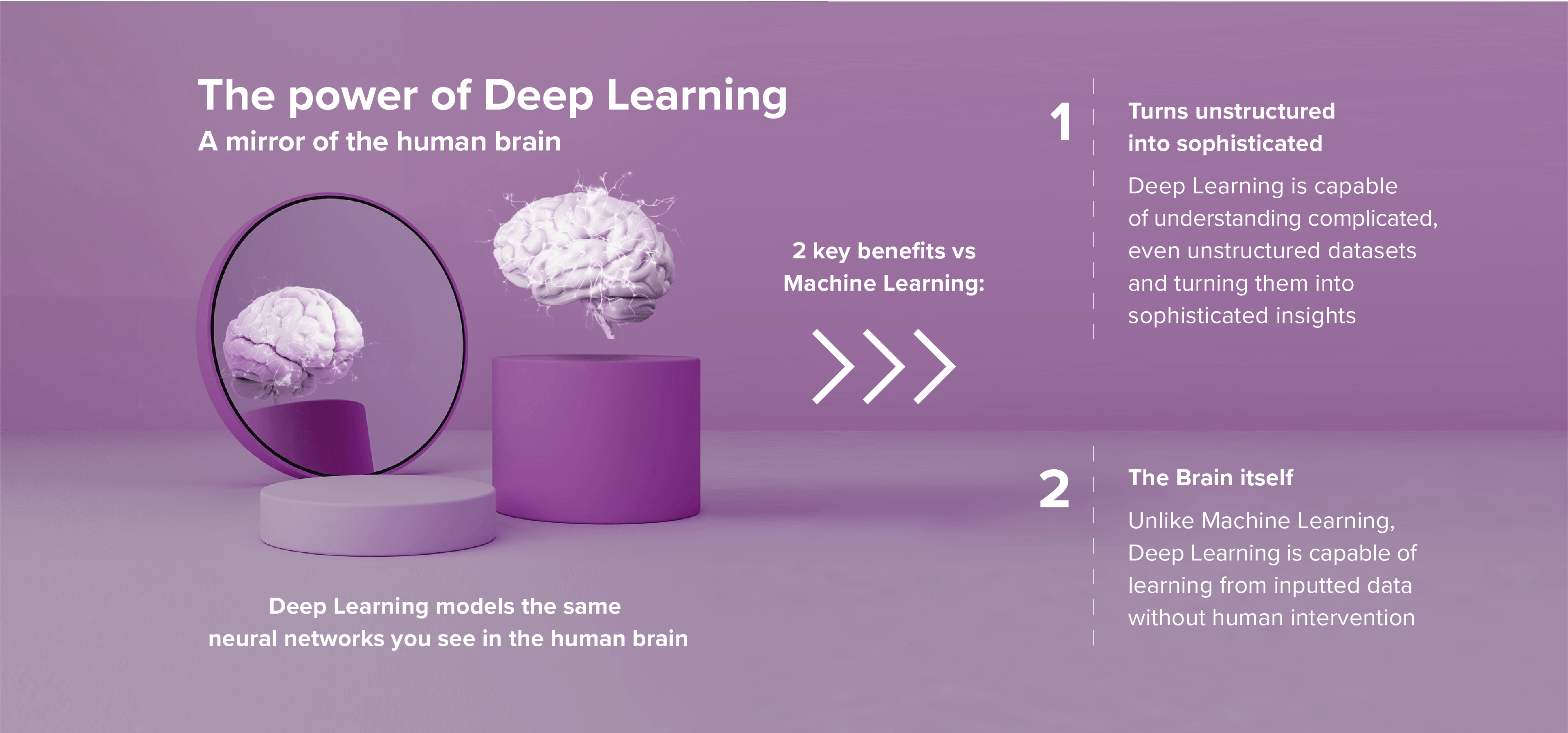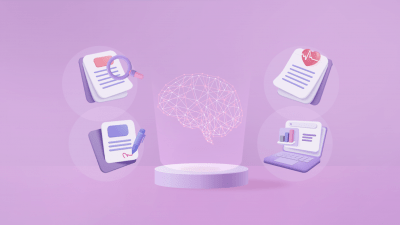Last Updated on: 23rd May 2024, 11:54 am
From the printing press to Deep Learning, the history of marketing shadows all our great leaps forward in communications technology. It is the marketer’s job to identify how these novel technologies can be used to reach potential customers, and educate them about products and services that enrich their lives.
The printing press let us create posters, radio and television enabled us to speak to people in their homes, and the internet gave us new ways to sell to people. Today, we’d like to take a moment to dive into how marketers can take advantage of the next big leap forward in technology: Deep Learning.
In this article you will learn:
- What Deep Learning is.
- Why and how Deep Learning is used in the marketing.
- How can the usage of Deep Learning algorithms boost your marketing strategy.
- Other benefits of Deep Learning in business.
Table of Contents:
- What is artificial intelligence, and why does it matter?
- What is Machine Learning?
- What is Deep Learning, and how does it work?
- Deep Learning vs. Machine Learning
- Why is Deep Learning so important?
- How is Deep Learning used in marketing?
- Benefits of Deep Learning in marketing
- Challenges of Deep Learning application
- What can you expect in the future?
- Deep Learning can help boost any kind of marketing campaign
What is artificial intelligence, and why does it matter?
Artificial Intelligence (AI) is probably one of the most misunderstood technologies today. In popular discourse, it conjures up images of robot uprisings, mass unemployment, and the dreaded singularity. Fortunately for humanity, this is broadly fiction, at least for now.
In reality, our brains are the product of millions of years of evolution and are significantly more sophisticated than any AI we are capable of producing. However, while the human brain is great at problem-solving, it tends to struggle when given repetitive tasks and large datasets.
This is where artificial intelligence is truly useful, not as a replacement for humans, but as a way to free us from tasks we don’t enjoy and that would be far too time-consuming for a human, for example, big data-sets. This empowers us to concentrate on what we do well. Artificial intelligence covers a huge variety of use cases, and it’s used in everything from video games to spell-checkers and even cars.
For our purposes, one of the most important forms of AI is called Machine Learning.
What is Machine Learning?
Machine Learning is often used by scientists and other researchers to search large datasets for patterns. These patterns can then be reviewed by humans in order to curate meaningful insights.
Rather than requiring a developer to enter specific parameters, Machine Learning is able to use algorithms and statistical models to “learn” and adapt without explicit instructions from the user, and make increasingly accurate insights about the data you feed it. However, Machine Learning has to be taught how to learn and analyze the best outcome. Deep Learning solutions don’t require this kind of support.
Machine Learning is most useful when dealing with large, structured datasets like Excel spreadsheets or curated databases. However, it is generally ill-suited to more complicated tasks, such as gathering data from images or videos. This is where we come to the next great leap forward: Deep Learning.
What is Deep Learning, and how does it work?
Deep Learning helps computers learn and make sense of things by themselves. The algorithm’s neural network is inspired by the human brain, where information flows through many interconnected layers. These layers help the computer recognize increasingly complicated patterns and make decisions based on the data it’s given. The process of teaching the computer involves showing it lots of examples, and it learns from its mistakes. In essence, it’s as if the computer is constantly fine-tuning its knowledge to become better at tasks, just like we do when we gain more experience from practice.
This self-improvement ability is why Deep Learning is often used for tasks like image recognition, speech understanding, and natural language processing, and it’s the technology behind many innovative solutions like voice assistants, recommendation systems, and self-driving cars. Deep Learning makes machines smarter by drawing inspiration from the human brain’s operation, helping them tackle complex tasks with less human guidance.
Deep Learning has revolutionized many fields by achieving remarkable levels of accuracy in tasks that were once considered challenging for computers. It has become an essential technology in the era of big data, as it can sift through massive amounts of information to find important insights and trends. Whether it’s helping medical professionals diagnose diseases, enhancing the accuracy of financial predictions, or enabling more efficient digital marketing, Deep Learning is at the forefront of cutting-edge solutions that are shaping the future of technology.
Deep Learning vs. Machine Learning
To put it simply, Deep Learning is a specialized technique within the larger field of Machine Learning, which itself is a part of the broader domain of Artificial Intelligence. While traditional Machine Learning methods can be effective for various tasks, Deep Learning excels at handling extremely complex data and has been a driving force behind many recent AI breakthroughs, making it a vital component of the AI landscape.

Unlike traditional Machine Learning algorithms, where we need to tell the computer what to look for, Deep Learning allows the computer to figure out by itself what’s important in the data. It’s like it learns to recognize patterns and make connections without us having to guide it every step of the way.
While the technology is more complicated to design, it allows us to generate much more sophisticated insights from any dataset, including unstructured datasets. As a result, Deep Learning is able to process data through varying layers of complexity, and derive meaningful insights faster than traditional Machine Learning solutions can.
You can check out this article on Machine Learning vs. Deep Learning if you’d like to know more.
Why is Deep Learning so important?
Deep Learning is particularly useful for two reasons. The first is that it can understand complicated, unstructured, datasets from multiple sources. Secondly, it is capable of learning from inputted data without human intervention. This allows it to react to new data, and become smarter the more often it is used.

Deep Learning vs Machine Learning
One of the most well-known examples of Deep Learning is Tesla’s self-driving technology, which has proven a massive challenge for the company and involves solving many of the problems with generalized AI, which would be impossible without Deep Learning. It plays a critical role in enabling autonomous vehicles to navigate and make decisions on the road.
Haha, FSD 9 beta is shipping soon, I swear!
Generalized self-driving is a hard problem, as it requires solving a large part of real-world AI. Didn’t expect it to be so hard, but the difficulty is obvious in retrospect.
Nothing has more degrees of freedom than reality.
— Elon Musk (@elonmusk) July 3, 2021
Aside from self-driving cars, Deep Learning is behind many of the coolest modern inventions. Whether that’s Apple and other manufacturers using AI-powered cameras, the ability to color historical video and photos in an instant, or the ability to show customers adverts they actually want to see.
These are just a few more examples of how Deep Learning is applied in various fields to improve technology and make our lives more convenient and efficient:
- Image Recognition: Deep Learning is used in apps that can identify objects, people, and animals in photos and videos, enhancing security and enabling features like automatic tagging.
- Speech Recognition: It powers voice assistants like Siri and speech-to-text technology, making it easier to communicate with computers using your voice, and also facilitating voice search and transcription services.
- Natural Language Processing (NLP): Deep Learning is the magic behind chatbots, language translation, and sentiment analysis in social media, improving customer service and enabling global communication.
- Healthcare: Deep Learning is used for medical image analysis, disease diagnosis, and drug discovery, which can lead to earlier disease detection and more effective medical treatments.
- Recommendation Systems: It drives personalized recommendations on platforms like Netflix and Amazon, enhancing user experiences and helping users discover content they’re likely to enjoy.
- Finance: Deep Learning helps in fraud detection, stock market prediction, and risk assessment, contributing to safer financial transactions and more informed investment decisions.
- Gaming: It’s used to create intelligent characters and more realistic gameplay, making video games more immersive and challenging for players.
Take a look at our article to learn more about the top 20 Deep Learning applications you need to know.
How is Deep Learning used in marketing?
Any marketer will tell you that they deal with a lot of data, from many different sources. Understanding and interpreting this information is the key to deciding what ads to place, and where to place them, in order to hit key metrics and maximize return on ad spend (ROAS). In marketing Deep Learning trains computers to understand and respond to customer behavior more effectively. It’s like having a 24/7 marketing assistant that learns from a massive amount of data.
Deep Learning is particularly useful for companies with offerings that will appeal to multiple demographics for different reasons. For example, a bank may have an offering with multiple terms and conditions that would appeal to different target audiences, or an automotive company might have a car that appeals to both speed-lovers and tech enthusiasts. If you’re an online store owner, Deep Learning can analyze what products customers look at, what they buy, and what they ignore.
In the past, marketers would need to manually interpret this data, which took up a significant amount of time and energy. Deep Learning offers a way to automate this process and generate better insights than a human would be able to. It analyzes the patterns and helps you show the right products to the right people at the right time.
Audience Construction:
Deep Learning has a number of specific applications in a marketing context. The first is in audience construction. Deep Learning is able to take data from a variety of sources, including first- and third-party data, and use that to construct a profile for an individual, or a group of individuals.
This allows marketers to construct granular audiences and serve them highly personalized adverts, without compromising user privacy. Given the rising user awareness surrounding privacy issues in advertising, this is a very useful feature.
Personalized Retargeting:
How often have you gone to make a purchase, added something to the cart, and then become distracted and forgotten about it? Personalized retargeting can be used to identify users who didn’t follow through with a purchase, and remind them why they loved that product in the first place.
It can be used to encourage registration, revive lapsed users, or reduce cart abandonment.
Contextual Targeting:
Contextual targeting is often overlooked as old-fashioned, but Deep Learning technology has breathed new life into it. RTB House’s ContextAI solution is powered by Deep Learning, and is able to determine the content that target users engage most with, and decide what kind of creatives to display on the site to entice them to click. This approach is rarely used in retargeting but is an invaluable part of our branding campaigns.
For example, if your data shows that a specific audience is interested in a holiday in Greece, you can use this data to show them adverts with items they might need for their trip such as swimsuits or water sports gear.
Cookieless Targeting:
The key strength of Deep Learning is data interpretation. This will make it particularly useful in the near future as markers are compelled to find new sources of data in order to replace third-party tracking cookies.
Deep Learning is able to understand diverse, non-standard data sources. This will allow companies employing it to get an edge on the competition as we move away from tracking cookies.
Additionally, we can use this technology to derive better insights from less data. This enables marketers to make the most of whatever information they have on hand, which will be particularly useful as the number of reliable data sources shrinks in the future.
Benefits of Deep Learning in marketing
Now that we understand how Deep Learning works and how it can be applied to marketing and other industries, let’s summarize the benefits of the technology.
What is the reason for the high effectiveness of Deep Learning in marketing?
Deep Learning and real-time bidding
More than half of all marketing budgets are allocated to purchasing ad placements programmatically. This is in the context of rising ad spending in a growing ecommerce landscape. Marketing decision-makers are tasked with making their budgets go further.
The mechanism that makes all of this possible is known as real-time bidding. It’s a near-instantaneous process and happens in less than the blink of an eye between a given user landing on a particular site and an ad appearing on-screen. In the space of mere milliseconds, there’s a flurry of frenzied activity fed by advanced AI systems. These systems are weighing up how much to bid for the placement against the statistical likelihood of user engagement. The more sophisticated the technology, the better able it is to accurately assess the value of showing an ad to a specific person at a given time.
Deep Learning not only excels at this task, it also wins with its ability to personalize ads to match the user. It’s a statistical powerhouse that learns and optimizes, and it outperforms standard Machine Learning approaches.
Better recommendations
Because of the transition from physical stores to omni-channel business models and online shopping in recent years, the ability to anticipate customer behavior in ecommerce has grown in importance. Because if you can more accurately predict customer behavior, you can sell products and services more effectively.
71% of consumers now expect a personalized experience from brands. There are benefits for consumers and brands alike—a more personalized experience provides a more comfortable and convenient purchase journey for a user. That use is likely to respond with an elevated perception of a brand and loyalty.
When Deep Learning is deployed in ecommerce, be it in retargeting, branding, or prospecting campaigns, it learns with each passing second, resulting in a faster and more precise analysis of buying potential, and can communicate with a higher degree of addressability, i.e., personalization. According to our analysis, the effectiveness of recommendations can increase by up to 41% compared to campaigns that do not use Deep Learning.
Deep Learning algorithms are not only able to ascertain which product to display to a user at a given time but also decide what kind of ad creative will best serve the purpose of generating engagement. To fully leverage this, your brand should find a provider with a wide portfolio of great-looking creatives that precisely align with your branding aesthetic.
Predicting consumer behavior
Beyond its expertise in predicting user engagement in discrete instances, Deep Learning in business can better predict sales levels for whole promo periods, seasons, and even years.
With a deeper analysis of user behavior, Deep Learning can tell brands which products are likely to be in demand in any upcoming period. This enables brands to have more efficient warehouse management—shipping high-demand products to warehouses in advance and clearing low-demand products, for example, through discount or cross-selling channels.
This is, of course, of great benefit to ecommerce brands with a high through-flow of products where warehousing space is at a premium. Think no further than sizable brands with massive product inventories, such as those found in Marketplaces, Home & Garden, and Fashion.
Advanced AI also allows brands more streamlined supply chain management—a more accurate prediction of consumer trends informs better efficiency to the entire length and breadth of the supply chain. With Deep Learning, companies can push predictive analytics to new levels, detecting potential issues before they arise. Overall, supply chain visibility can also be improved, allowing for better customer relationships and quicker delivery fulfillment, with optimized routes for cost reduction and enhanced productivity.
Exposing the hidden
Deep Learning in retargeting has not only made it possible to analyze basic user behaviors, such as which products or product categories are visited, but also other hidden data. With Deep Learning in marketing, it is possible to analyze the visit time on products and the sequence of visited subpages in a store. Using data, machines interpret exactly what users did at the store and thereby predict their actual purchase intentions. It is possible to determine which products users are most interested in and, thus, send them customized offers with which they are most likely to engage.
Custom optimization
With all this data, the next step is deciding how to present an offer in an ad and in what order. Deep Learning algorithms analyze offers and how attractive they are from a user’s perspective. Deep Learning is much more sophisticated than classic retargeting, as the products displayed on an ad are more personalized. This approach makes it possible to implement a rule where there is otherwise no clear pattern for a particular group of users. The algorithms understand each user on a deeper level; they look for the best deals and the order in which the offers should appear on the ads for the users.
Real-time updates
Our behavior profiles are constantly changing. Deep Learning in marketing can build a real-time behavioral profile and adjust what is presented on a banner every time an ad is displayed. Algorithms determine what should be shown on each banner, adjusting the contents based on a user’s responses to previous offers. Thanks to powerful algorithms and constant analysis, Deep Learning can rebuild user behavior profiles in real time.
Challenges of Deep Learning application
While Deep Learning is undeniably powerful and offers cutting-edge solutions, it comes with some challenges. Here are some points worth considering before you implement the technology in your business:
- Data Dependency: Deep Learning models require substantial amounts of high-quality data for training. Obtaining and preparing this data can be time-consuming and expensive.
- Complexity: Developing Deep Learning algorithms can be challenging due to their complexity. They often involve intricate architectures and require expertise in neural network design.
- Computational Resources: Training Deep Learning models demands significant computational power, which can be expensive and energy-intensive.
- Interpretability: Deep Learning models are often seen as “black boxes” because it can be challenging to understand how they arrive at their decisions, raising concerns about transparency and trust.
- Overfitting: Deep Learning models are prone to overfitting, where they perform well on the training data but struggle with new, unseen data. This requires careful regularization techniques.
Deep Learning technology is generally quite complicated to build and even more challenging to scale successfully, but don’t let the challenges discourage you. There are ways around this, for example, at RTB House, we have followed the Apple model by building software that is specifically optimized for the hardware we use.
This allows us to understand exactly what our specs are and ensure that our solution uses every bit of potential power on offer. With this, we can run Deep Learning algorithms in the seconds required to successfully respond to a bid request, or select the right creative for the right user.
What can you expect in the future?
The unceasing and dynamic development of technology, as well as great interest shown in the subject of artificial intelligence among the world’s largest corporations, allow us to assume that the possibilities of using Deep Learning in everyday marketing activities will grow from year to year. Just think of the game-changing potential of ChatGPT, which is already being put to work in marketing in areas such as sharpening messaging and gathering insights. There are also untold possibilities outside of Deep Learning in marketing in spheres such as medicine—designing new remedies and treatments—and in developing measures to limit environmental damage and counteract climate change.
Deep Learning is a wellspring of potential, being flexible enough to adjust to any change or challenge, and there’s no bigger change on the horizon for marketing than cookieless.
Deep Learning in business works perfectly wherever decisions are made on the basis of data. Therefore it is expected that the algorithms will help marketers better plan and deliver their campaigns. This is especially important in the context of the decision to retire third-party cookies by Google.
Can Deep Learning still be a superpower with cookieless?
The demise of third-party cookies will mean greater data privacy for billions of internet users, but it represents a seismic change for online advertisers. Without cookies that track user behavior across sites, the personalization of messages becomes more challenging. However, it’s a challenge that Deep Learning is uniquely able to meet and still display highly personalized ads to individuals without collecting personal data. It will remain the most powerful tool in the cookieless era, helping brands to scale campaigns with highly relevant messaging.
It can do this with a winning combination of cookieless tools that are already in place, such as contextual targeting and Google’s Protected Audience API. And the time is nigh as the deadline for cookieless depreciation—early 2025—looms large.
Brands should immediately seek out early adopters and testers of cookieless solutions that have a significant head start on companies that continue to rely on outdated methods.
Deep Learning can help boost any kind of marketing campaign
Whether you’re looking for better ways to target users, alternative tools for the cookieless future, or a way to understand what your customers are actually looking for, Deep Learning can probably help you boost your marketing efforts and free you up to concentrate on the tasks that you excel at.
Every single one of RTB House’s products is enhanced by Deep Learning. This makes us a great way for marketers to take advantage of Deep Learning technology, without needing to build the solutions themselves.
If you’d like to learn more about Deep Learning, and how you can implement the technology into your workflow, our team would love to speak to you – just head to the contact page here.





